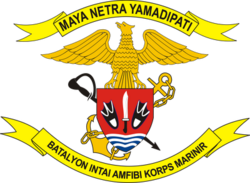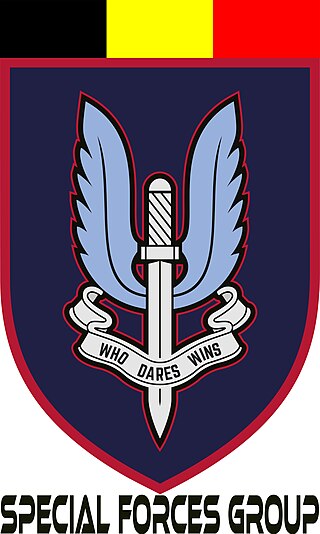
A commando is a combatant, or operative of an elite light infantry or special operations force, specially trained for carrying out raids and operating in small teams behind enemy lines.

United Kingdom Commando Force (UKCF), previously called 3 Commando Brigade, is the UK's special operations-capable commando formation of the Royal Marines. It is composed of Royal Marine Commandos and commando qualified personnel from the Royal Navy, British Army and Royal Air Force.

The South African Special Forces Brigade, colloquially known as the Recces, is South Africa's principal Tier 1 special operations forces, specialising in various types of operations, including counter-insurgency, long-range-reconnaissance, unconventional-warfare, and hostage rescue. The brigade operates with two active-duty groups, with 4 Special Forces Regiment focusing on maritime operations, and 5 Special Forces Regiment focusing on land and airborne operations. Only about 8% of recruits who undergo South African special forces training pass the course.

Marines are military personnel generally trained to operate on both land and sea, with a particular focus on amphibious warfare. Historically, the main tasks undertaken by marines have included raiding ashore and the boarding of vessels during ship-to-ship combat or capture of prize ships. Marines also assisted in maintaining security, discipline, and order aboard ships. While maintaining many of their historical roles, in modern times, marines also engage in duties including rapid-response operations, humanitarian aid, disaster relief, special operations roles, and counter-terrorism operations. In most nations, marines are an integral part of that state's navy, such as the United Kingdom's Royal Marines; in some countries their marine forces can also instead be part of the land army, such as the French Troupes de Marine; or, more uncommonly, a nation’s marine forces may be an independent military branch such as the United States Marine Corps or the Ukrainian Marine Corps.
The name commando has been applied to a variety of Australian special forces and light infantry units that have been formed since 1941–42. The first Australian "commando" units were formed during the Second World War, where they mainly performed reconnaissance and long-range patrol roles during Australia's campaigns in New Guinea and Borneo, although other units such as M and Z Special Units performed more clandestine roles. These units were disbanded following the end of the war; however, in the 1950s it was realised that there was a need for such units again in the Australian forces. Today, the Australian Army possesses a number of units that perform more conventional direct-action type commando roles, as well as counter-terrorism response, long-range patrolling, and clandestine deep-penetration operations.

Taifib is an elite recon unit within the Indonesian Marine Corps which is tasked for conducting amphibious reconnaissance and special reconnaissance. It is operationally similar to the Combat Reconnaissance Platoon from the Army's Kostrad corps. Taifib was previously known as Kipam which literally means in English: the Para-Amphibious reconnaissance Commandos, it was formed in 1961.
The American-180 is a submachine gun developed in the 1960s which fires the .22 Long Rifle or .22 ILARCO cartridges from a pan magazine. The concept began with the Casull Model 290 that used a flat pan magazine similar to designs widely used prior to World War II. Only 87 Casull M290s were built, as the weapon was expensive to manufacture. The American-180 is an improved version. A semi-automatic only variant called the American SAR 180/275 is still produced on a custom basis by E&L Manufacturing of Riddle, Oregon.
Operation Argon was an unsuccessful military operation carried out by South African special forces in May 1985 with the objective of destroying six fuel storage tanks at Malongo in Angola's Cabinda exclave.
The Special Forces Regiment (SF) (Sinhala: විශේෂ බලකාය Visēsha Balakāya;) is a special forces unit of the Sri Lanka Army. Founded in 1986 as a combat tracker team, it was established as a regiment in 1988, and later expanded into a brigade. The unit specialises in a number of roles including counter-terrorism, direct action and covert reconnaissance. Much like the British Army Special Air Service, much of the information about the SF is highly classified due to the secrecy and sensitivity of its operations.

The Special Forces Group is the only tier one special forces unit in the Belgian Land Component and part of the Special Operations Regiment.

Special reconnaissance (SR) is conducted by small units, such as a recon team, made up of highly trained military personnel, usually from special forces units and/or military intelligence organizations. Special reconnaissance teams operate behind enemy lines, avoiding direct combat and detection by the enemy. As a role, SR is distinct from commando operations, but both are often carried out by the same units. The SR role frequently includes covert direction of airstrikes and indirect fire, in areas deep behind enemy lines, placement of remotely monitored sensors, and preparations for other special forces. Like other special forces, SR units may also carry out direct action and unconventional warfare, including guerrilla operations.
Operation Kerslig was a South African Defence Force special forces raid on an oil refinery outside Luanda, Angola. The raid took place on 30 November 1981 by members of the 1 and 4 Reconnaissance Regiments.

The Honoris Crux of 1975, post-nominal letters HC, is a military decoration for bravery which was instituted by the Republic of South Africa on 1 July 1975. The decoration was awarded to members of the South African Defence Force for bravery in dangerous circumstances. It was the junior in a set of four Honoris Crux decorations in four classes, which together replaced the discontinued Honoris Crux of 1952.
Rear Admiral Arne "Angel" Söderlund is a retired South African Navy officer and author.
The Hunter Group was formed in 1968, as an experimental, non military group, with members of the group passing on some of their training (unofficially) onto other units of the South African Army.
Operation Nobilis was a special forces and naval operation in 1984 by the South African Defence Force (SADF) during the Angolan Civil War and South African Border War. Its objective was the destruction of three Angolan OSA missile boats in Luanda harbour with alternative targets of other Angolan naval or commercial transport vessels in the military harbour.
Operation Lark was two special forces naval operations in 1978 conducted by members of the South African Navy (SADF), 4 Reconnaissance Regiment and Rhodesian SAS during the South African Border War. Its objective was the assassination of Robert Mugabe at his residence in Maputo, Mozambique.







